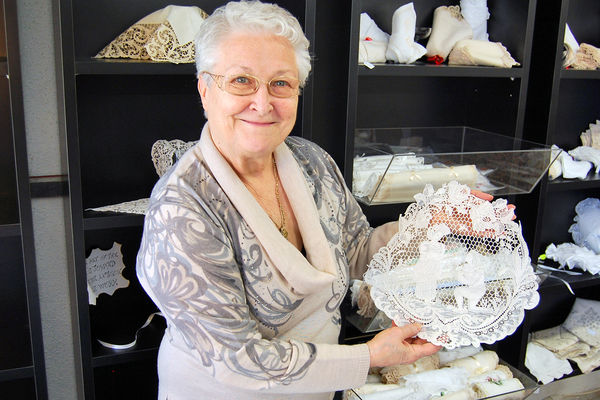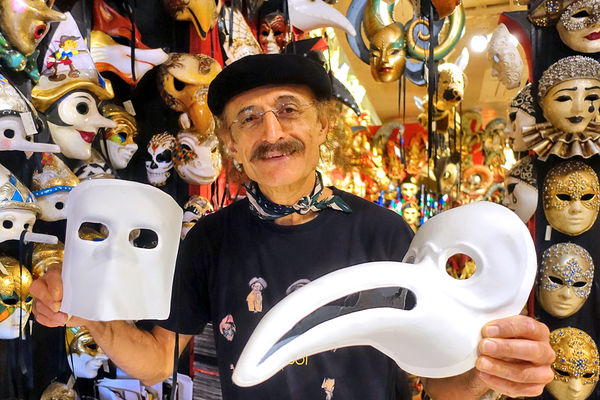Bring Home a Bit of Venetian History
By Rick Steves

Long a city of aristocrats, luxury goods, and trade, Venice has an amazing culture. Its fantasy-world atmosphere of elegant decay is like nowhere else in Europe. But with souvenir hawkers everywhere pushing cheap masks, glassy baubles, and lacy doilies, alongside all the usual souvenir trinkets, Venice can come across as little more than a tacky tourist trap. Look behind those tired clichés when souvenir shopping, though, and you'll get glimpses of Venice's history.
Masks
Venice's ubiquitous, ornately decorated masks are more than just colorful souvenirs — they come with a story. In the 1600s, masks were a practical tool in a physician's medical bag. When attending plague victims, the doctor crammed the beak-shaped nose of his mask with herbs, hoping to filter the air and prevent the spread of the dreaded disease. (Venice's position as a trade hub made it especially susceptible to plague.)
In the 1700s, when Venice was Europe's party town, masks became a big part of Carnevale celebrations, the weeks-long Mardi Gras festivities leading up to Lent. Since everyone wore masks, all social classes partied as one. The most popular masks were based on characters from the lowbrow comedic theater called "commedia dell'arte": the trickster Harlequin, the beautiful and cunning Columbina, the country bumpkin Pulcinella, and the sad clown Pierrot.
Even outside Carnevale season, high-class Venetians traditionally enjoyed the anonymity of a mask. To avoid awkward questions while out and about doing less-than-respectable things — gambling at the casino or patronizing a brothel — they donned a simple mask that hid half of their face, along with their identity.
Masks and Carnevale celebrations pretty much died out with the Venetian Republic, which ended when Napoleon took over in 1797. But the tradition made a dramatic comeback in the 1970s, when the Carnevale was revived. Step into a mask shop today, and you'll see a forest of beautifully painted samples. The best stores have workshops where you can watch masks being made (such as Ca' Macana, near Campo San Barnaba, or the workshop of Stefano Gottardo, at the end of Calle Lunga Santa Maria Formosa).
Glass
Glass is older than ancient Rome, but by the Middle Ages, Europe had forgotten how to make it. The Republic of Venice, though, with strong commercial ties to the Middle East and Byzantium, relearned glass techniques from its trading partners.
Venetian glass became a coveted luxury, and Venice closely guarded the secrets of its production. After a series of devastating fires at glass factories in the 13th century, Venice's ruler, the doge, relegated all glassmaking to the lagoon island of Murano. It's just as likely that the doge intended to isolate the glassworkers and their workshops to keep competitors away and protect the Venetian monopoly.
Artisans have been producing their venerable glass on Murano ever since. It was on Murano that glassmakers first figured out how to make pure, transparent glass and perfected the technique called millefiori — "1,000 flowers" — in which layers of colored glass evoke a many-colored bouquet.
If you're serious about buying glass, steer clear of the cheap knickknacks (most likely from China) in tourist shops. To sample the art form, visit one of Murano's showrooms, some of which have adjoining workshops that welcome the public. The glass museum on Murano (Museo del Vetro) is a good place to train your eye before you shop.
Lace
Just as Murano is known for glass, the lagoon island of Burano is famous for lace. Back in the day, fishermen's wives kept themselves busy mending nets, an occupation said to have evolved into lace making about 500 years ago.
Burano specializes in "needle lace" — made only with needle and thread (no bobbins). At the height of Burano's popularity, fine Venetian tablecloths and linens embellished Europe's most prestigious homes, and needle lace decorated cuffs, gowns, and frilly collars with intricate flowers, leaves, and curling stems.
Lace lovers will find the journey to Burano worthwhile. Shops proudly display painstakingly produced pieces, made by meticulously following time-honored patterns passed down from older generations. (But beware: Plenty of machine-made lace is on view there as well.)
Production of needle lace has declined, in no small measure because of the time it takes to finish even a small piece; a tablecloth can take 30 workers and three years to complete. But residents cherish the art form and are working to ensure its survival. Burano's Museo del Merletto (lace museum) is a good first stop for visitors, with a first-rate collection and frequent lace-making demonstrations.
I'm not big on souvenir shopping, and I'll always prioritize a memory-creating experience over any material memento. But I appreciate that Venice has preserved essential aspects of its history and culture by maintaining its craft traditions. Picking up a mask, glass piece, or lace item as a reminder of your trip is a great way of capturing the essence of Venice for years to come.

